Building a Resilient Financial Strategy
Daftar Isi Artikel
Creating a resilient financial strategy involves preparing for uncertainties and ensuring that your business can withstand various challenges. Key strategies include:
- Scenario Planning: Develop multiple financial scenarios to anticipate different potential outcomes, such as economic downturns, market disruptions, or changes in regulatory environments. Scenario planning helps in crafting flexible strategies that can adapt to various situations.
- Contingency Funds: Establish contingency funds or reserves to cover unexpected expenses or financial shortfalls. Having a financial cushion provides stability during periods of uncertainty and ensures business continuity.
- Crisis Management Plans: Create and regularly update crisis management plans that address potential financial emergencies. Plans should include steps for managing cash flow, communicating with stakeholders, and navigating operational disruptions.
- Regular Reviews: Conduct regular reviews of your financial strategy and performance. Periodic evaluations help identify areas for improvement, assess the effectiveness of risk management strategies, and adjust plans as needed.
Strengthening Financial Relationships and Networks
Building and maintaining strong financial relationships and networks can support resilience and growth. Key practices include:
- Investor Relations: Cultivate strong relationships with investors by maintaining transparent communication, providing regular updates, and addressing concerns promptly. A solid investor base can offer financial support and stability during challenging times.
- Banking Partnerships: Develop strong partnerships with banks and financial institutions. Establishing a good relationship can facilitate access to credit, favorable loan terms, and financial advice.
- Advisory Networks: Build a network of financial advisors, mentors, and industry experts who can provide guidance, support, and insights. Leveraging external expertise can enhance decision-making and strategic planning.
- Professional Associations: Engage with professional associations and industry groups to stay informed about trends, regulations, and best practices. Networking within these groups can lead to valuable connections and opportunities.
Enhancing Financial Literacy Across the Organization
Improving financial literacy among employees at all levels contributes to better decision-making and overall financial health. Consider the following approaches:
- Educational Programs: Implement educational programs focused on financial literacy, including budgeting, financial planning, and understanding financial statements. Tailor programs to different roles and levels within the organization.
- Workshops and Seminars: Host workshops and seminars on relevant financial topics, such as risk management, investment strategies, and financial forecasting. Interactive sessions can enhance learning and engagement.
- Resources and Tools: Provide access to financial resources and tools that support financial planning and management. Resources such as budgeting tools, financial calculators, and online courses can be valuable for employees.
- Continuous Learning: Foster a culture of continuous learning by encouraging employees to pursue further education and certifications in finance and related fields. Ongoing development supports career growth and organizational success.
Leveraging Data and Technology for Financial Excellence
Advancing Financial Technology (Fintech) Integration
Fintech innovations offer numerous opportunities for enhancing financial management and operational efficiency. Key areas for fintech integration include:
- Digital Payments: Adopt digital payment solutions to streamline transactions and improve payment processing efficiency. Digital wallets, mobile payments, and blockchain-based solutions can enhance convenience and security.
- Automated Accounting: Implement automated accounting systems to reduce manual processes and improve accuracy. Automated tools for invoicing, expense tracking, and reconciliation can save time and reduce errors.
- Data Analytics: Utilize advanced data analytics tools to gain insights into financial performance, customer behavior, and market trends. Data-driven insights can inform strategic decisions and optimize financial management.
- AI and Machine Learning: Leverage AI and machine learning for predictive analytics, fraud detection, and personalized financial recommendations. These technologies can enhance decision-making and risk management.
Utilizing Big Data for Financial Insights
Big data provides valuable insights that can drive strategic financial decisions. Key considerations for leveraging big data include:
- Data Integration: Integrate data from various sources, such as sales, customer interactions, and market trends, to gain a comprehensive view of financial performance. Unified data provides a more accurate basis for analysis.
- Predictive Modeling: Use predictive modeling techniques to forecast financial outcomes and identify potential risks. Predictive models can help anticipate changes in revenue, costs, and market conditions.
- Real-Time Analysis: Implement real-time data analysis to monitor financial performance and make timely decisions. Real-time insights enable quick responses to emerging opportunities and challenges.
- Customer Segmentation: Analyze customer data to segment markets and tailor financial strategies to different customer groups. Targeted approaches can improve financial outcomes and customer satisfaction.
Enhancing Cybersecurity Measures
As financial data and transactions become increasingly digital, robust cybersecurity measures are essential for protecting sensitive information. Key cybersecurity practices include:
- Data Encryption: Implement encryption protocols to protect financial data during transmission and storage. Encryption ensures that sensitive information is secure from unauthorized access.
- Access Controls: Establish strict access controls to limit who can view and modify financial data. Use multi-factor authentication and role-based access to enhance security.
- Regular Audits: Conduct regular cybersecurity audits to identify vulnerabilities and assess the effectiveness of security measures. Address any weaknesses promptly to prevent potential breaches.
- Employee Training: Provide cybersecurity training for employees to raise awareness about potential threats and best practices for data protection. Well-informed employees are less likely to fall victim to cyber attacks.
Driving Sustainable Financial Growth
Fostering Innovation and Continuous Improvement
Continuous innovation and improvement drive sustainable financial growth and competitive advantage. Key strategies include:
- Innovation Culture: Cultivate a culture that encourages creativity and experimentation. Support initiatives that explore new financial technologies, processes, and business models.
- Feedback Loops: Establish feedback loops to gather input from employees, customers, and stakeholders. Use feedback to identify areas for improvement and refine financial strategies.
- Benchmarking Best Practices: Benchmark financial practices against industry leaders and adopt best practices that enhance efficiency and effectiveness. Staying ahead of industry trends can lead to better financial performance.
- Investment in R&D: Invest in research and development (R&D) to explore new opportunities and improve financial processes. R&D efforts can lead to innovative solutions that drive growth and efficiency.
Scaling Financial Operations
As businesses grow, scaling financial operations effectively is crucial for sustaining success. Key considerations include:
- Scalable Systems: Implement financial systems and processes that can handle increased transaction volumes and complexity. Scalable systems support growth and maintain operational efficiency.
- Process Optimization: Continuously optimize financial processes to improve efficiency and reduce costs. Streamline workflows and eliminate bottlenecks to enhance productivity.
- Resource Management: Manage resources effectively to support scaling operations. Ensure that financial teams and technologies are equipped to handle increased demands.
- Growth Strategies: Develop and execute growth strategies that align with financial capabilities and goals. Consider organic growth, acquisitions, and partnerships as potential avenues for expansion.
Conclusion
Achieving long-term financial success requires a multifaceted approach that encompasses strategic planning, innovation, resilience, and continuous improvement. By integrating financial goals with business objectives, leveraging advanced technologies, and fostering a culture of financial literacy and accountability, businesses can navigate challenges and seize opportunities for growth.
Building a robust financial infrastructure, enhancing stakeholder relationships, and preparing for future trends are essential components of a sustainable financial strategy. Embracing these practices not only strengthens financial performance but also positions organizations for enduring success in an ever-evolving landscape.
As businesses move forward, staying informed, adaptable, and proactive will be key to thriving in a dynamic and competitive environment. By prioritizing effective financial management and fostering a culture of innovation, organizations can achieve lasting prosperity and make a positive impact on their stakeholders and the broader community.




